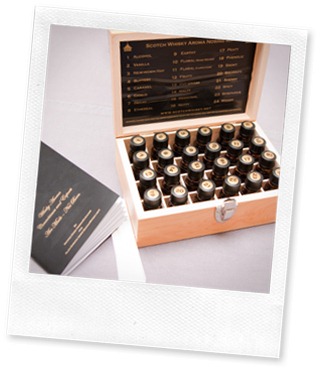
Nearly two years ago, I’ve got the Scotch Whisky Aroma Nosing Kit as a gift for my birthday. It contains a booklet, a tasting record sheet and 24 samples of pure aroma chemicals, selected and developed by a Scottish perfumer and a whisky expert. The nosing kit is presented in a nice wooden box.
After two years, I think I can evaluate.
The aroma samples
The aromas are well chosen and well made. There is vanilla, hay, caramel, citrus, fruity, flowery, malty, nutty, peaty, smoky, sherry, woody… and even ‘decay’ (the dirty kind of sulphur). Although more than 300 aromas are found in whisky, they provide a basic map for the possible directions.
Some of them are vague though: “fruity” is just one sample but in the real world there are lots of different fruits that are quite easy to discern. The same goes for “spicy”. Other aromas are left out. I suppose you’ll have a hard time defining a typical Brora or Springbank using only these 24 ‘obvious’ aromas.
Since they are basically alcohol solvents, the makers suggest to use a tasting strip and let the alcohol evaporate before nosing. I think it’s better to nose the bottles, because your whisky will also include alcohol that will not evaporate. The biggest challenge in learning how to nose, is to filter out the alcohol smell from a whisky and detect only the subtle flavours underneath. Nosing straight from the bottles would be a lot easier if they had a bigger opening.
It’s worth noting that some of my samples are half empty after less than two years, even though I’ve used the tasting strips only once. The alcohol will slowly evaporate just by opening the bottles every now and then. It’s safe to say some samples will be useless after three or four years, even when you don’t use the kit intensively.
The aroma guide and box
The wooden box is a nice touch but the execution is a bit poor (notice the big air bubbles under the sticker on the lid? some of the wooden dividers were broken as well). The 40 page booklet contains an introduction to the kit, the nosing process, the vocabulary of nosing, etc.
Most of the information can be easily found in books or online. The most interesting part of the guide are 10 pages with explanations of the actual aromas. A bit of background information is given about the molecular composition or similarities between aromas, but often I’m missing the link to whisky itself. Which distilleries or regions are likely to show a certain aroma? Why does a certain aroma show up in whisky? What about wood types and their associated aromas? I feel the guide is a bit too generic and only really useful when you have a certain level of experience already.
The price
The kit is sold for € 130 (EU customers) or $ 214 (non-EU), shipping included. Most people I’ve spoken to seem to think this is too much, but maybe you can share the cost with a couple of friends and pass the box around.
Compared to wine aroma kits such as “Le nez du vin”, it seems a correct pricing, although I must admit these wine kits look much more attractive with a professional layout and full colour booklets.
Conclusion
The Scotch Whisky Aroma Nosing Kit is quite an interesting tool for whisky enthusiasts who want to sharpen up their detection skills. The samples are generally good which is the most important element. The price may be relatively high but there simply isn’t an alternative.
For beginners, I fear this won’t actually learn you how to nose a whisky. The guide is too limited to achieve this, and you’ll need interaction with more experienced people who can learn you how to apply the knowledge about the basic aromas to a variety of real-world whiskies. I think a few miniatures of different types of whisky (selected as a typical example of a specific aroma) could be an interesting improvement for beginners, or at least a certain written guidance to the profiles of different distilleries.
More info on their website